Trees Birds Mammals Fish Amphibians Reptiles
Wild Algarve
Bookshop



Bardsey Island - Ynys Enlli National Nature Reserve
Designations: Ynys Enlli SSSI, Aberdaron Coast and Bardsey Island SPA and Seacliffs of Lleyn SAC
Bardsey Island lies some 3km (2 miles) off the coast of the Llyn Peninsula, in Northwest Wales, and is internationally renowned for its wealth of wildlife. The island is home to hundreds of beautiful and in some instances rare species including lichens, liverworts and mosses.
Bardsey also has spectacular seabird life, and many bird species nest on the island's sea cliff ledges and other protected habitats. Manx Shearwaters (Puffinus puffinus) arrive by the thousand each year to breed and raise their young on the Bardsey.
The reserve is managed by the Bardsey Island Trust, telephone 08458 112233.
Below: Bardsey Island seen from the mainland
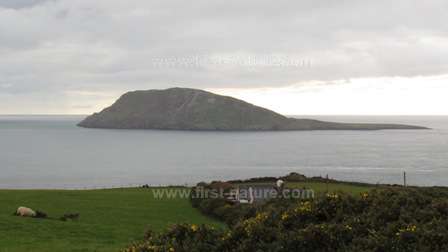
If history and archaeology are of interest to you then Bardsey has a lot to offer. The most prominent monument on the island is a thirteenth-century Abbey Tower, but many earth structures have also been found some of which date back two- or three-thousand years. Round huts and rectangular structures are present on the island, and they appear to have been farm buildings dating back to the Middle Ages.
There is a legend that Bardsey is the last resting ground of twenty-thousand saints. Some must have come from outside Wales, surely! There are many graves in and around the Abbey, although nowhere near the number required to give credence to this legend.
Visiting Bardsey
It is possible to visit Bardsey for day trips. Rental accommodation, managed by the Bardsey Island Trust, is also available for visitors to the island who would like to stay there a while. The boat trips leave from Aberdaron and are subject to weather conditions, and so you should always check with the organisers before setting off on your journey. Sailing time from Aberdaron to Bardsey is about 20 minutes, and the journey can sometimes be described as 'choppy'!
Frequency and timing of boat trips
In the season there are usually three boat trips to the island each morning, departing at approx. 09.30, 10.30 and 11.30. Boats return in the afternoon at 13.30, 14.30 or 15.30. This arrangement allows for about four hours exploration time on Bardsey, but this will vary depending on the weather conditions on the day.
Parking Arrangements
For week-long holidays there is a secure car park at Cwrt Farm, just outside Aberdaron. You should arrive not later than 9.30am on the day of your departure, and your luggage will be transported to and from the boat at either end of your journey. The walk down to the beach where the boat departs from at Aberdaron takes about 15 minutes.
Day Trip visitors to the island should park in the National Trust Car Park, which is almost immediately opposite the entrance to Cwrt Farm - see below for directions.
Directions
Grid Ref: SH117213 - Aberdaron Boat embarkation Car Park, Cwrt Farm
From Pwllheli follow the A499 signed Abersoch until you reach Llanbedrog, and then turn right onto the B4413 signed to Aberdaron. You will pass through Mynytho, Botwnnog, Sarn Meyllteyrn, Pen-y-groeslon and Rhoshirwaun before reaching the outskirts of Aberdaron.
Once you have passed the Aberdaron sign take the right-hand turn signposted Uwchmynnyd and then about 100 metres later take the left-hand turn towards Tir Glyn. Proceed along this lane until you see Cwrt Farm on your right.
People staying for a week on Bardsey should drive into the farm, turn right after the house, and park in the small field on the right-hand side.
If you are going to Bardsey for a day only, continue just past the farm and then turn left down a track into the National Trust car park.
Facilities
There is a Visitor Centre on Bardsey with public toilets. The island is also home to the Bardsey Island Bird and Field Observatory, where studies are made of bird migration patterns and monitoring of nesting birds is also carried out. Although heavily 'bird orientated' the Observatory also provides a base for visitors carrying out research in many other fields of study; in recent years the Observatory has hosted marine biologists, botanists and many other interested parties.
There is also a farm cafe on the island which is open daily from 11am to 1pm.
How to stay on Bardsey
There are two ways of organising a stay on Bardsey Island:
Below: The Lighthouse and flowers in summer - picture Mike Alexander, NRW
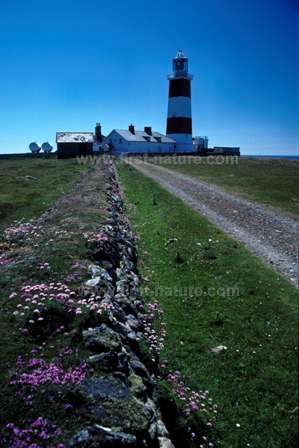
Bardsey Island Trust
The trust has a number of self-catering houses, sleeping from two people to parties of eight, which can be rented on a weekly basis. The houses are furnished, and there are gas cookers and fridges in the kitchens along with basic cooking utensils.
Blankets are supplied for the beds but you are required to bring other bedding and towels with you.
Food supplies should be brought along, too, although it is sometimes possible to buy vegetables and eggs from the island farm. The Observatory (see below) has a store of food which is for those staying there, but they will supply other visitors who get stranded on the island by inclement weather. Each house has an outside chemical toilet situated in the garden.
Bardsey Island Bird and Field Observatory
The Observatory also has accommodation for parties of up to 12 people on a self-catering or fully-catered basis. Couples and families can be accommodated, too, but if no single rooms are available note that sleeping will be in single-sex multi-occupancy rooms.
More details...
Access
There are marked paths around the island, and visitors are asked to keep to the paths to minimise disturbance to the birds and other wildlife on Bardsey.
Description of Site
Bardsey Island, itself a SSSI, is part of several sites around the mainland coast of Lleyn Peninsula that form the larger SAC and SPA and are renowned for their outstanding wildlife including birds, plants and marine species.
Below: Hoopoes are one of the unusal birds that drop in on Bardsey Island on a fairly regular basis
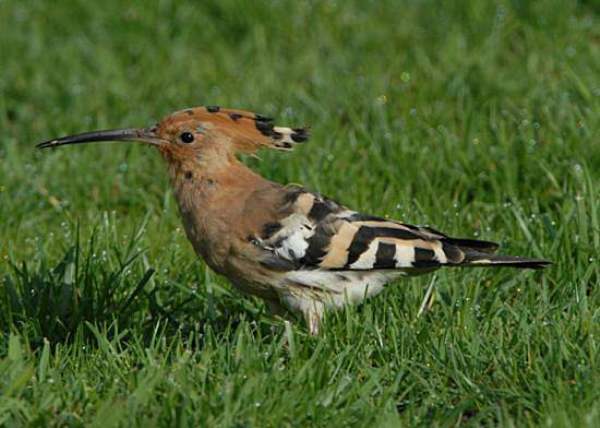
Viewed from the mainland, Bardsey Island looks somewhat unappealing because the highest part of the island (the Mountain, as it is called) screens the rest of the Bardsey landscape from view. It is only on arrival on the southern side, with its area of maritime heath awash with bright pink Thrift Armeria maritima and mauve Spring Squill Scilla verna early in the year, that the beauty of the island is revealed. The western part has gentle slopes and small fields divided by stone walls, and it is here that the sheep and ponies, kept by the one remaining farm, graze.
The island extends to around 440 acres in total, and 80 per cent of it is is agricultural use.
Birding on Bardsey
From early spring onwards Bardsey Island is a mecca for birdwatchers, especially for those interested in bird migration - although this has far less to do with 'natural' factors such as geographical position than most would imagine. The reason that so many migrating birds are attracted to Bardsey Island is to do with a lighthouse that was built there in 1821. Birds are attracted by the light, which flashes every 15 seconds. This was as much a curse as a benefit to the birds initially, as many were killed as a result of colliding with the lamp and surrounding buildings, but 1978 a 'false' lighthouse was built close to the original structure to draw birds away from the dangers and into the safer territory of the maritime heathland where many (up to 3,000) roost overnight before continuing on their long journeys.
It was the increasing numbers of bird watchers making the journey to Bardsey to witness the amazing bird passage that led to the opening of the Bird Observatory in 1953. The work carried out there has made a considerable contribution to our knowledge of bird migration and populations in and around Wales. Some 200 bird species have been recorded and ringed by staff at the Observatory.
Below: Ten to sixteen thousand pairs of Manx Shearwaters breed on Bardsey Island each year
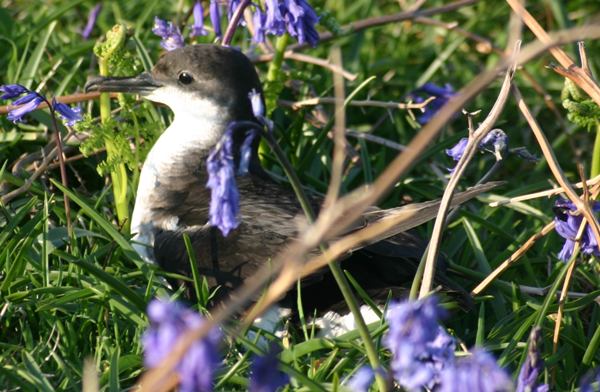
Resident birds on Bardsey include Kestrels (Falco tinnunculus), Peregrines (Falco peregrinus), Northern Lapwings (Vanellus vanellus), Little Owls (Athene noctua), Rock Pipits (Anthus petrosus) and Curlews (Numenius arquata). Ravens (Corvus corax) and Choughs (Pyrrhocorax pyrrhocorax) live there, too.
From February onwards bird diversity increases with the arrival of the summer visitors such as Common Redstarts (Phoenicurus phoenicurus), Pied Flycatchers (Ficedula hypoleuca), Spotted Flycatchers (Muscicapa striata), Common Swifts (Apus apus), various warblers, Whimbrels (Numenius phaeopus), and Sandpipers. Then there's the occasional surprise when out-of-the-ordinary birds drop in, including Hoopoes (Upupa epops), much better known from the Mediterranean, where these lovely birds are frequently seen on newly-mown golf courses.
Below: Golden Hair Lichen is one of the rare species that occur on Bardsey Island
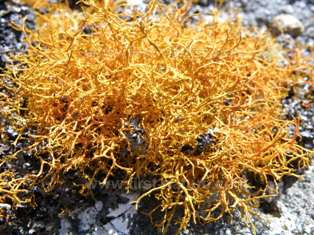
Of Bardsey's nesting birds the Manx Shearwater is a real speciality, with ten- to sixteen-thousand breeding pairs arriving from March onwards each year. The shearwaters take over disused rabbit burrows on the tops of the cliffs to raise their young hidden away from predators. The only sure way to see these iconic birds is to stay overnight on the island and witness their nightly return from hunting grounds far out at sea.
By returning to feed mates and chicks after darkness has fallen Manx Shearwaters avoid some (but not all) of the enemies, notably Black-backed Gulls, that would prey on them if they came back during daylight.
Manx Shearwaters are most at home in the air and at sea, and they move slowly and awkwardly on land. This makes them easy targets for marauding gulls and other birds on the lookout for food for their own chicks.
Below: Autumn Lady's-tresses flower in late summer on Bardsey
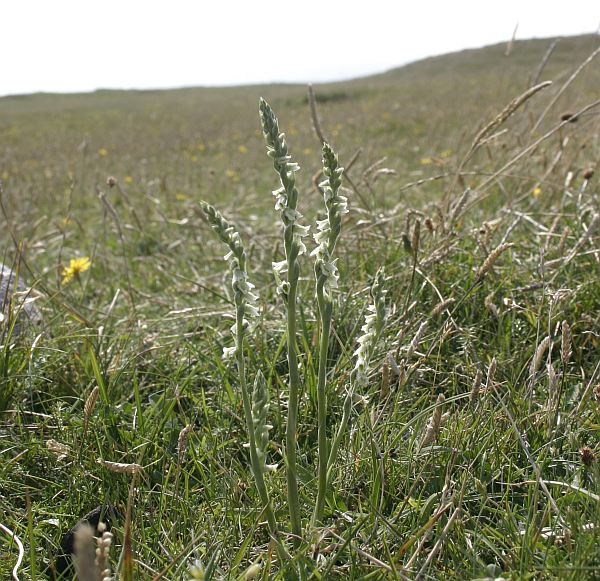
The bird life on Bardsey is so amazing that it is easy to lose sight of the many other attractions of the island. Although Bardsey has but a limited shoreline its coastal habitats are very varied, resulting in a rich and diverse marine flora and fauna. Atlantic Grey Seals (Halichoerus grypus) are seen in the rocky bays of the island, and a few pairs breed there most years. Large areas of swaying seaweeds are a feature of the sea close to the coast, while in the deeper water sea-squirts and sponges cling to the rocks. The rock pools are home to crabs, sea anemones and small fish, and if you are really lucky you may find a Yellow Star Anemone - a species more common in the Mediterranean but sometimes found in rock pools of Bardsey. Risso's Dolphins and Harbour Porpoises are often seen in the ocean around the island.
If plants are your main interest, Bardsey has much to offer. The grasslands and heaths burst into bloom beginning with Spring Squill (Scilla verna) and Thrift (Armeria maritima), which are soon followed by a succession of other flowering plants. The island is also home to more than 350 kinds of lichens that cling to rocky habitats; they include the rare Ciliate Strap Lichen (Heterodermia leucomela) and Golden Hair Lichen (Teloschistes flavicans).
The island is not renowned for its wild orchids, but if you visit in late summer there is a nice colony of Autumn Lady's-tresses (Spiranthes spiralis) nestling between the farm buildings and the landing stage.
Also growing on the island are some unusual apple trees - the Bardsey Apple. The tree produces fruit that seems to be particularly resistant to the diseases that normally afflict apples. As a result of investigation at the National Fruit Collection in Brogdale in Kent, the tree and its fruit were declared as unique.
Because of the abundance of flowering plants on Bardsey, there is also plenty of insect life to enjoy. Butterflies on the wing over the flowery grasslands include the Painted Lady (Vanessa cardui), Small Tortoiseshell (Aglais urticae) and Common Blue (Polyommatus icarus).
Slideshow pictures courtesy Mike Alexander NRW